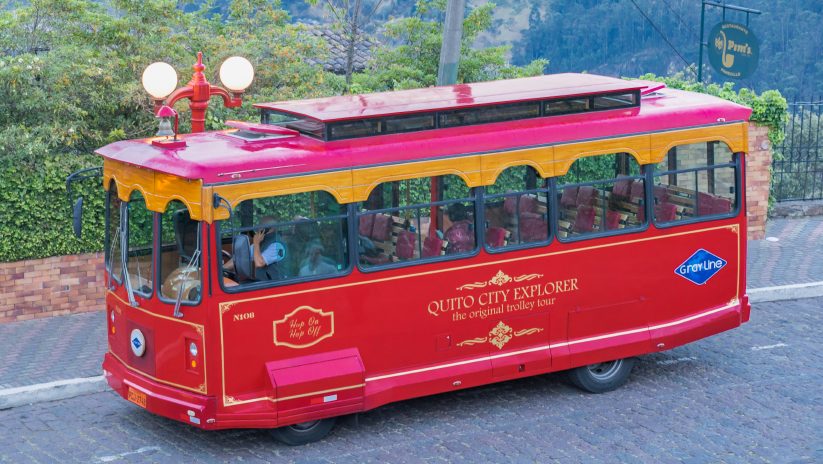-
2026/04/29
New York(LGA) -
2026/04/30
Quito
(Updated: June, 09, 2025 11:11)
Quito
Population
City Code
-
UIO
Popular Airlines
Klm Royal Dutch Airlines
American Airlines
LATAM Airlines Chile
Flight Time
5~9 hours
The flight time to Quito is approximately 5~9 hours. Find out more about the history, economy, climate and transportation options before you visit Quito.
Compare Airfares for Flights to Quito
Compare airfares for Domestic Flights within Ecuador to Quito
Quito, a World Heritage city nestled in the Andes right on the equator
Nestled high in the Andes and straddling the equator, Quito is a breathtaking World Heritage city that seamlessly blends rich history, vibrant culture, and modern energy, making it one of South America's most compelling travel destinations. As the capital of Ecuador, Quito boasts a beautifully preserved colonial center filled with centuries-old churches, plazas, and monasteries, recognized by UNESCO for its historical significance. Its status as a leading tourism city is reinforced by a wide range of attractions—from panoramic viewpoints like El Panecillo to bustling local markets, museums, and the nearby equatorial monument at "La Mitad del Mundo." Quito also serves as a gateway to Ecuador’s ecological wonders, including the Amazon and Galápagos Islands, making it both a cultural and logistical hub. Supported by a growing economy with opportunities in tourism, commerce, and international services, and with easy access via the modern Mariscal Sucre International Airport, Quito is an ideal base for travelers seeking adventure, heritage, and convenience all in one vibrant city.
History
Quito, one of the oldest capitals in South America, holds deep historical significance as a former Incan city later transformed by Spanish colonization into a center of colonial art, architecture, and culture. Its location in a high-altitude valley in the Andes, directly on the equator, made it both geographically strategic and naturally stunning—offering breathtaking mountain views and a unique equatorial climate. Designated as the world’s first UNESCO World Heritage city in 1978, Quito has preserved its cobblestone streets, baroque churches, and colonial plazas, even as it has grown into a modern urban hub. Its careful urban development has merged heritage conservation with infrastructure expansion, helping the city rise as a leading tourism destination in Latin America. Today, Quito attracts millions of visitors with its rich blend of history, geography, and cultural depth, serving as both a gateway to the Galápagos and a world-class destination in its own right.
Economy
As Ecuador’s capital and second-most populous city, Quito plays a central role in the country’s regional economy and is increasingly recognized as a key business hub in Latin America. Home to a diverse range of industries including finance, telecommunications, and technology, the city has attracted numerous international companies and embassies, creating a strong foundation for global economic engagement. With a population of nearly 3 million, Quito has the urban scale to support both large-scale commerce and entrepreneurial ventures, bolstered by growing infrastructure and connectivity through the modern Mariscal Sucre International Airport. The city’s economic appeal is further enhanced by its close ties to the tourism industry, which brings in millions of visitors annually and fuels the hospitality, retail, and cultural sectors. As a UNESCO World Heritage site and economic engine, Quito uniquely blends heritage with modern opportunity, making it a strategic destination for both tourism and investment.
Budget Airfares
Quito is highly accessible for both international and domestic travelers, thanks to the modern Mariscal Sucre International Airport (UIO), which serves as one of the busiest and most advanced airports in South America. Located about 18 kilometers east of the city center, the airport offers a wide range of direct and connecting flights from North America, Europe, and across Latin America, with budget airlines such as JetSMART and Wingo providing affordable travel options. With its modern facilities, efficient customs processing, and frequent service, the airport supports Quito’s role as a major travel hub. Upon arrival, travelers can reach the city via airport shuttles, taxis, rideshare services, or private transfers, with reliable access to both urban and rural destinations. Quito’s public transport system, which includes buses, trolleys, and the newly developed metro line, adds to the convenience of navigating the city, making it a well-connected destination that appeals to both leisure and business travelers alike.
Local Climate / Weather
Quito enjoys a unique high-altitude equatorial climate that offers spring-like weather year-round, making it a comfortable destination for travelers in every season. Situated over 9,000 feet above sea level in the Andes, the city maintains mild temperatures ranging between 50°F (10°C) at night and 70°F (21°C) during the day, with two primary seasons—dry and wet. The dry season, from June to September, is the most popular for tourism, offering clear skies and ideal conditions for sightseeing and outdoor adventures. The wet season, typically from October to May, brings afternoon showers but still allows for morning excursions and cultural activities. This consistent yet varied weather pattern not only enhances Quito’s natural beauty but also supports year-round tourism, making it an attractive choice for international travelers seeking cultural immersion, scenic landscapes, and adventure without extreme weather disruptions.
Transportation Modes
Quito boasts a growing and efficient transportation system that supports both local commuting and tourist mobility, making it easier than ever to explore this historic Andean city. The backbone of public transport includes an extensive bus network and the recently launched Quito Metro, Ecuador’s first subway system, offering fast, clean, and affordable service across major city corridors. Buses, including trolleybuses and articulated eco-friendly units, are widely used and connect various neighborhoods, tourist zones, and commercial areas. For more personalized travel, taxis and rideshare services like Uber and Cabify are readily available and affordable. The compact layout of the historic city center, along with pedestrian-friendly streets and growing bike infrastructure, also makes walking and cycling convenient for short-distance exploration. With its mix of modern transit and local charm, Quito’s transportation system enhances accessibility and enriches the overall tourism experience for visitors.
Travel FAQs
What kind of airport is there in Quito?
Quito is served by Mariscal Sucre International Airport. The airport is named after the first president of Bolivia.
How is the safety in Quito? Are there things to be cautious about?
The new city area of Quito is relatively safe both day and night, with regular foot traffic. However, the old city area is known for being less secure, with frequent incidents of theft and robbery. It is especially dangerous at night when fewer people are around, so it is advisable to avoid going out after dark.
How many days are recommended for sightseeing in Quito?
A stay of about 1 to 2 nights is recommended for sightseeing in Quito.
What are some famous tourist attractions in Quito?
Due to its high elevation, Quito is not hot, and although it may not seem like it, it is actually located right on the equator. Popular tourist spots include the Equator Monument and the Equator Museum. There are also several grand-looking churches in the old town area, but due to security concerns, it's best to visit during daylight hours.


